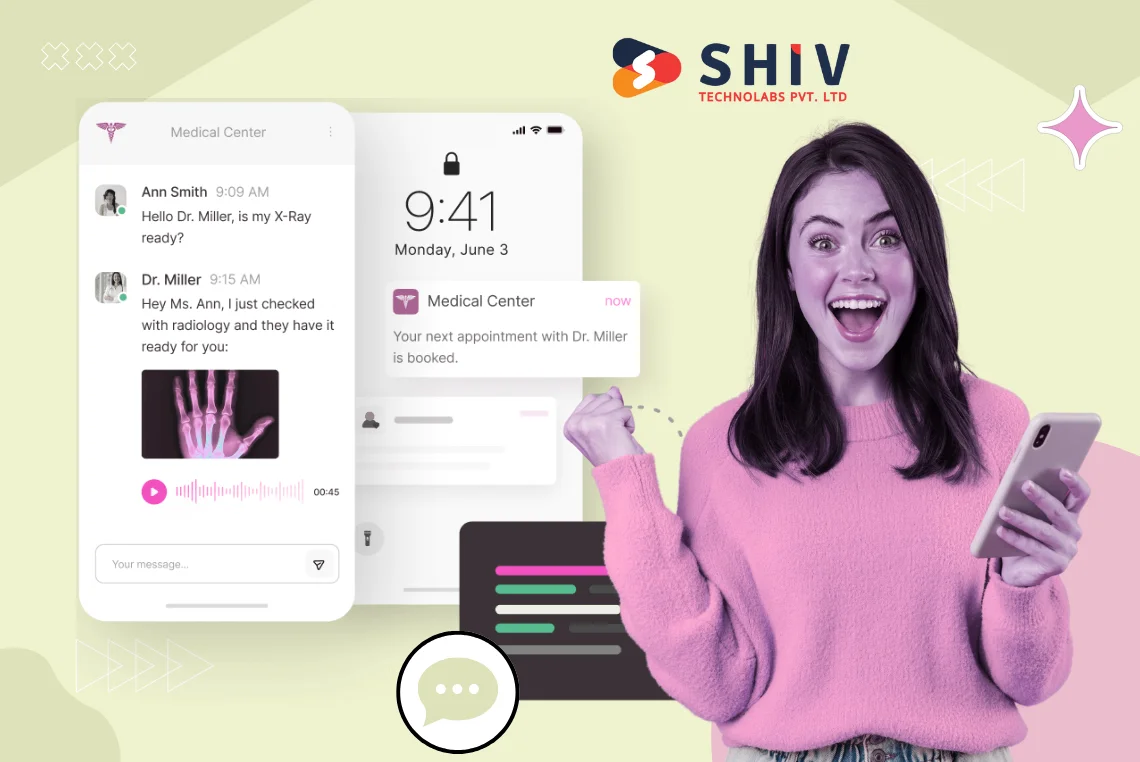Table of Contents
In-app chat is a messaging feature that allows users to send and receive messages within a mobile application, without switching to another app. It’s used across food delivery, taxi booking, eCommerce, healthcare, and many other apps to simplify communication between users, service providers, and support teams.
When users get the help they need without leaving the app, they tend to stay longer, complete more tasks, and return more often. That’s why in-app chat is more than a “nice to have”—it’s becoming a standard expectation.
Let’s break down what in-app chat means, where it’s used most, and why businesses are making it a priority.
Where In-App Chat Shows Up—and Why It Works So Well?
Let’s skip the textbook explanation. Instead, imagine the friction users feel when chat is missing:
- A delivery driver is lost but can’t reach the customer.
- A user has a billing question, and there’s no support contact in the app.
- A patient needs a quick follow-up but has to wait for an email reply.
Now here’s how in-app chat fixes it:
1. Delivery Apps:
Riders and couriers don’t need to call each other. One message inside the app gets the job done.
2. Service Booking Apps:
Customers can ask about delays or give special instructions directly from the booking screen.
3. Healthcare & Wellness Apps:
Patients send questions to doctors or fitness coaches while tracking their progress.
4. Rental or Marketplace Apps:
Buyers and sellers chat to settle delivery details, price, or availability—all without sharing personal numbers.
It works because it saves time, reduces confusion, and makes people feel heard.
What Makes Users Stick Around? Conversations.

You can pack your mobile app with features, but if users can’t talk when they need to, they’ll leave.
Here’s what in-app chat quietly fixes behind the scenes:
1. It keeps users inside the app.
When there’s a question, chat gives them a reason to stay. No bouncing to another channel.
2. It builds trust.
Talking to a real person inside the app feels direct and personal, even if it’s a bot answering first.
3. It reduces drop-offs.
If something goes wrong mid-checkout or mid-booking, support chat can step in before the user quits.
4. It gives your brand a voice.
Literally. The tone, response time, and friendliness of your messages shape how people feel about your product.
Why In-App Chat Is Becoming the Default for Mobile Apps?
It’s easy to assume in-app chat is just a support feature. But for many apps, it’s the core of the user experience.
Think about it:
- You don’t wait for a reply when booking a ride—you message the driver.
- You don’t call the restaurant about an order—you send a quick chat.
- You don’t email customer service when something feels off—you open the chat bubble.
In-app chat removes the distance between people and services. It’s faster than email, less intrusive than a phone call, and more trackable than any third-party app.
What Makes an In-app Chat Feature Useful?
A good in-app chat system doesn’t just send messages—it makes conversations easier, faster, and more reliable. Users don’t think about “features”—they notice what works and what doesn’t.
Key things users expect:
- Messages sent and received instantly
- Clear read and delivery status
- Simple media sharing (images, files, audio)
- Typing indicators for live feedback
- Smooth experience on any network or device
When these basics are covered, the chat feels responsive and human. That’s what keeps users coming back.
Frontend, Backend, and Everything in Between
Let’s look at the basic tech structure that brings all of this to life inside a mobile app:
1. Frontend (What Users See):
- Built using mobile frameworks like Swift (iOS), Kotlin (Android), Flutter, or React Native
- Includes the chat interface, message bubble layout, media preview, and input actions
- Ties directly into the backend via API or WebSocket for real-time updates
2. Backend (What Makes It Work):
- Handles message routing, storage, and delivery tracking
- Usually includes a chat server (custom-built or managed)
- Can integrate with databases, moderation tools, and analytics platforms
3. Protocols That Keep Messages Moving:
- WebSockets: Best for live, two-way chat
- MQTT: Lightweight and good for apps with frequent messaging
- HTTP Polling: A fallback where full real-time isn’t needed
4. Scalability Tools:
- Redis for message queues
- Load balancers for high-traffic handling
- CDN for faster media delivery
The right combination depends on how your app will be used, how many users you expect, and what kind of messages will be sent.
What About Privacy? Users Notice More Than You Think

In a world where users are more careful with their data, your chat system must be built with privacy in mind, right from the start.
1. End-to-End Encryption
Every message, image, or file sent through the app should be encrypted from sender to receiver. This keeps conversations private, even from your servers.
2. Message Retention Controls
Apps should clearly define how long messages are stored, and let users delete chat history when needed.
3. Role-Based Access
Only certain users (like admins or support staff) should have access to specific chats. No one else should be able to peek.
4. Blocking and Reporting
Any in-app chat system must include controls for users to block others or report abuse. Without it, chat becomes a risk.
5. Compliance with Standards
Apps in healthcare, finance, or education may need to follow laws like HIPAA, GDPR, or COPPA. Your chat system must align with these.
Designing a Chat UI That Feels Natural
Even with all the tech in place, users will still judge the experience based on how the chat looks and feels. A messy interface, laggy typing, or poor text wrapping will kill interest fast.
Here’s what to keep in mind:
- Keep the send button always visible
- Use a clean chat bubble design with time stamps
- Load older messages smoothly as users scroll up
- Make media previews clickable and full-screen capable
- Allow quick replies or canned messages if your app uses chatbots
It’s not about making chat pretty. It’s about making it useful—without effort from the user’s side.
The Real Challenge: Keeping It Working Across Devices and Networks
Your users could be on a 5G connection or stuck in a basement with bad Wi-Fi. They could be on iOS or Android, old phones or new ones.
This means your chat system must be able to:
- Store and resend undelivered messages
- Show status updates (like “waiting for network…”)
- Handle sync across multiple logins
- Deal with message retries in background mode
- Compress media for faster uploads
Building in-app chat for mobile isn’t a weekend project. It’s a serious engineering task with deep UX decisions. That’s why so many apps either use SDKs or hire external teams to handle it right.
Should You Build It from Scratch or Use a Chat SDK?
If your app needs full control over chat behavior, interface, and data, you’ll probably build it. If speed, reliability, and low effort matter more, you’ll go with an SDK.
1. Build from scratch if:
- You have in-house developers experienced with real-time systems
- You need to host chat data in a specific region
- You plan to offer chat as a unique feature, not just support
2. Use an SDK/API if:
- You need to launch faster
- Your chat needs are standard (support, order updates, user-to-provider)
- You want lower maintenance overhead
- You need something that works well across both iOS and Android
Both paths work—you just need to pick the one that matches your goals and timeline.
Tools That Help You Add In-App Chat Faster
If you’re not building everything from scratch, these tools help speed up the process while keeping performance high.
| Tool | Best For | Notes |
|---|---|---|
| Firebase | Quick setup for mobile apps | Simple real-time chat, great for MVPs |
| Sendbird | Full-featured messaging | Works well across Android, iOS, and web |
| Twilio Conversations | Scalable chat logic | Good for apps with complex chat flows |
| PubNub | High-volume chat apps | Fast message delivery at a global scale |
| Socket.IO | Real-time custom apps | Flexible if you’re handling your backend |
Each of these platforms has its strengths.
- Firebase is great for fast rollouts.
- Twilio offers fine control over logic.
- Sendbird balances speed and structure.
- PubNub handles massive scale.
- Socket.IO is ideal for apps with strong internal dev teams.
If you want to chat that’s reliable without building every part yourself, these options help you ship faster, without cutting corners.
Where In-App Chat Fits in On-Demand Apps
If you’re building an app where timing, service, or real people are involved, chat isn’t a nice-to-have. It’s part of the experience.
- Food delivery apps: Drivers and customers often need to update location, notes, or drop-off instructions.
- Ride-hailing apps: Riders message drivers about pickup points, without leaving the ride screen.
- Service apps: Plumbers, therapists, or house cleaners need real-time instructions before arriving.
- Telehealth or learning platforms: Patients or learners ask follow-up questions, report issues, or request help instantly.
If your mobile app falls within any of the above-mentioned models, our on-demand development services help you plan and build it from the ground up, including in-app chat.
What Should You Track Once It’s Live?
Adding in-app chat is just step one. To know it’s working, you’ll need to track what users are doing with it.
Key performance signals:
- Average messages per session: Is the chat being used enough?
- Response time: How quickly are replies happening (from users or bots)?
- Chat-to-conversion rate: Are chats helping users complete actions (book, order, buy)?
- Time to first reply: If there’s a delay, users will drop
- Conversation drop-off rate: Where are users quitting the chat?
These metrics tell you if your chat system is just there—or if it’s making a difference.
Data Speaks Louder Than Features
Still unsure how much it matters? Let’s look at the numbers:
- 63% of users say they’re more likely to return to an app if it offers real-time chat.
- 79% prefer chat over any other support channel inside mobile apps.
- 58% of users expect chat to be available in on-demand apps.
These aren’t trends—they’re habits. And habits shape app growth.
Common Issues Teams Face (And How to Handle Them)
No chat system is perfect from day one. Here are typical problems mobile teams run into:
Problem: Messages take too long to send on poor networks
Fix: Use retry logic and local caching
Problem: Users complain they missed replies when the app was closed
Fix: Improve push notification setup with message previews
Problem: Conversations feel cold or robotic
Fix: Add welcome messages, typing indicators, and human-style phrasing
Problem: Too many chats, not enough support agents
Fix: Use a chatbot to filter common questions, then hand off to humans
Solving these early keeps chat from becoming a support burden.
Ready to Build It Right?
If you’re planning an app with in-app chat—or thinking about adding chat to your current app—we can help.
Our mobile development team at Shiv Technolabs has built chat-powered apps for food delivery, healthcare, education, real estate, and on-demand services.
We offer:
- Feature-rich chat integration for both iOS and Android
- Custom UI that matches your brand
- Real-time messaging using Firebase, Sendbird, or your preferred tech
- End-to-end delivery—from design to live app
- Post-launch support and updates
📞 Contact us to build your chat-powered mobile app.
We’ll walk you through what to expect and help you get started—no pressure, just clear answers.






















